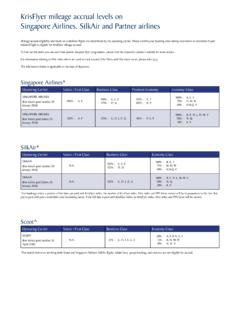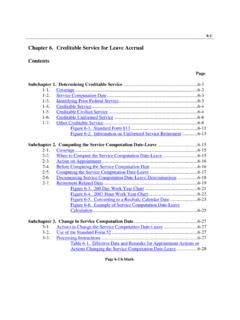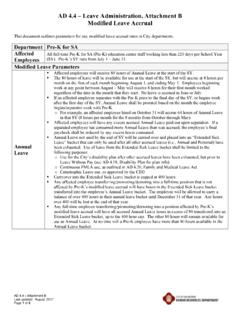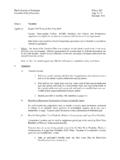Transcription of Performance Budgeting and Accrual Budgeting: …
1 ISSN 1608-7143 OECD Journal on Budgeting Volume 7 No. 2 OECD 2007109 Performance Budgeting and Accrual Budgeting : Decision Rules or Analytic Tools? byAllen Schick* Performance Budgeting and Accrual Budgeting are analytic tools thatprovide information and insights which are not available throughconventional approaches. But neither innovation is ready forwidespread application as a decision rule in the budget process. Thisarticle urges fuller understanding of these innovations and theirimplications, and more systematic use of Performance and accrualinformation for policy makers.
2 * Allen Schick is Visiting Fellow, Governance Studies, The Brookings Institution,Washington DC, and Professor, School of Public Affairs, University of Maryland,United Budgeting AND Accrual Budgeting : DECISION RULES OR ANALYTIC TOOLS?OECD JOURNAL ON Budgeting VOLUME 7 No. 2 ISSN 1608-7143 OECD 2007110 Budgeting is a process that transforms information into decision. Requestssubmitted by spending units or generated by central budget staffs are inputtedinto the process, and allocations to entities, projects and other recipients areoutputted. The quality of these decisions depends on the data available todecision makers, as well as on the analytic tools they use to process theinformation.
3 One of the perennial aims of budget innovation has been toinfluence the decisions that flow from the process by modifying theclassification or content of budget data and by introducing new analyticmethods. At one time, most countries classified expenditures by organisationunits and items to be purchased. Nowadays, most have economic andfunctional classifications, and many also classify expenditure by programmes,activities or outputs. As the stockpile of budget information has grown, themeans of analysis have multiplied. Innovative countries strive to measureperformance, medium-term fiscal impacts, exposure to contingent liabilitiesand other financial risks, the unit cost of producing government services, thelong-term sustainability of the government s fiscal position, the revenueforgone through tax preferences, the distribution of expenditure by region,social class and gender, and other contemporary issues in surge of data has spurred budget innovators to devise new rules forshaping the decisions that emerge from the process.
4 They want information tobe more than available: they want it to transform the way governments goabout budget work. They want different information to produce differentoutcomes. This article focuses on two contemporary efforts to convertinformation into rules. One is Performance Budgeting , which seeks to basespending decisions on actual or projected results; the other is accrualbudgeting, which calculates expenditure in terms of resources used orliabilities incurred. The first shifts budget decisions from inputs to outputs oroutcomes; the second shifts them from disbursements to cost.
5 Performancebudgeting and the Accrual basis are among the most prominent reforms onthe budget agenda. Neither is new, and neither has made as much headway asreformers would like, but both are likely to be promoted within governmentsand by some international organisations in the years Budgeting and Accrual Budgeting are analytic tools thatprovide information and insights which are not available throughconventional approaches. Both can also be framed into decision rules thatdictate the way governments allocate resources. One decision rule mightPERFORMANCE Budgeting AND Accrual Budgeting : DECISION RULES OR ANALYTIC TOOLS?
6 OECD JOURNAL ON Budgeting VOLUME 7 No. 2 ISSN 1608-7143 OECD 2007111specify that government should spend money to purchase outputs; anothermight require that government appropriate funds to cover the cost of goodsconsumed or liabilities incurred. Although both may seem to rationalisebudget choice, this article argues that governments should move cautiously incodifying Performance and Accrual Budgeting into decision rules. It isessential to develop a fuller understanding of these innovations and theirimplications before mandating that they be the basis of budget decisions.
7 Thearticle also urges, however, that governments incorporate Performance andaccrual information into the mainstream of data available to policy critical difference between analytic tools and decision rules lies inthe discretion permitted to politicians and officials when they makeallocations. When information is only an aid for analysis, governments mayopt to apply or disregard the proffered data, and they may interpret the dataas they deem appropriate. For example, armed with data showing that oneentity s unit costs are lower than another s, governments may neverthelessprovide more money to the high-cost operation.
8 Or, presented with accrualinformation, they may appropriate funds to cover cash outflows rather thanincurred liabilities. However, when information is codified into decision rules,budget makers are required to base allocations on it. To put the differencesimply: analytic tools empower budget makers, whereas decision rulesconstrain them. The former allow full scope for judgment and subjectivity, thelatter make Budgeting less judgmental and more distinction between analytic tools and decision rules may beexplained by considering the approaches taken by national governments inincorporating medium-term projections into budget work.
9 As recently as twodecades ago, few governments formally projected the future budget impactsof the decisions they made for the fiscal year immediately ahead. Nowadays,however, many governments construct forward estimates or baselines thatproject expenditures and other budget elements for each of the next three ormore years. These projections typically assume that current policies will becontinued without change; they thereby provide a basis for government toforecast the fiscal situation that will ensue if the budget policies already inplace are maintained. With this information at hand, governments canestimate the impact of proposed or approved policy changes on futurebudgets.
10 Using information in this way gives government a powerful analytictool to take account of future implications before it governments have gone further by constructing medium-termexpenditure frameworks (MTEF) that limit spending in each of the next threeor more fiscal years. This hard constraint bars government from takingactions that would cause estimated future spending to rise above the presetlimit. When it is used effectively, the MTEF converts projections from analytictools into decision rules. The MTEF greatly increases the probability thatPERFORMANCE Budgeting AND Accrual Budgeting : DECISION RULES OR ANALYTIC TOOLS?














